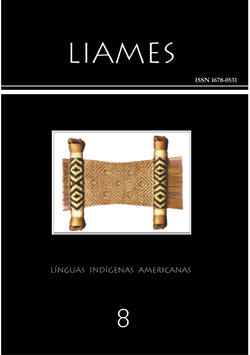Abstract
A grande maioria das línguas naturais induz seus falantes a representarem estados transitivos dos eventos, nesse processo determinadas entidades recebem maior atenção em detrimento de outras, tratadas como menos proeminentes. Da mesma forma, em muitas línguas os processos morfossintáticos evidenciam que as estruturas lingüísticas são sensíveis a uma hierarquia subjacente das entidades condicionadas por parâmetros de tipo semântico, referencial e/ou pragmático. Por exemplo, em línguas indígenas norte-americanas os argumentos se ordenam com base em uma hierarquia de animacidade em que a 1a e 2a pessoas ficam em um degrau mais alto da hierarquia, e os nomes inanimados em um degrau mais baixo. Nesse sentido, em uma construção sintática os marcadores no verbo podem indicar se o sintagma nominal [animado] é A (relação direta) ou se é P/O (relação inversa).
References
BICKEL, Balthasar; NICHOLS, Johanna. (2007) Inflectional morphology. In Timothy Shopen (ed.). Language typology and syntactic description, 2ª ed. Vol. III: Grammatical categories and the lexicon, pp. 169-240. Cambridge: Cambridge University Press.
COMRIE, Bernard. (1981) Languages universals and linguistic typology. Oxford: Blackwell.
CROFT, William. (2001) Radical construction grammar. Syntactic theory in typological perspective. Oxford: Oxford University Press.
DeLANCEY, Scott. (1981) An interpretation of split ergativity and related patterns. Language
(3):626-657.
DeLANCEY, Scott. (2001) Lectures on functional syntax. Notes for the Summer School held at the University of California at Santa Barbara, July 2001.
DIXON, R. M. W. (1994) Ergativity. Cambridge: Cambridge University Press.
DIXON, R.M.W.; AIKHENVALD, Alexandra. (1997) A typology of argument constructions. In Joan Bybee; John Haiman; Sandra Thompson (eds.). Essays on language function and language type. Dedicated to T. Givón, pp. 71-113. Amsterdam/Philadelphia: John Benjamins Publishing Company.
DIXON, R.M.W. (2000) Changing valency. Case studies in transitivity. Cambridge: Cambridge University Press.
FADDEN, Lorna. (2000) The inverse continuum. M.A. Thesis, Simon Fraser University.
GIVÓN, T. (1994) Voice and inversion. Amsterdam/Philadelphia: John Benjamins Publishing Company.
HARRIS, Alice; CAMPBELL, Lyle. (1995) Historical syntax in cross-linguistic perspective. Cambridge: Cambridge University Press.
KLAIMAN, M. H. (1991) Grammatical voice. Cambridge: Cambridge University Press.
NICHOLS, Johanna. (1992) Language diversity in space and time. Chicago: The University of Chicago Press.
The LIAMES: Línguas Indígenas Americanas uses the Creative Commons license (CC), thus preserving the integrity of the articles in an open access environment.


